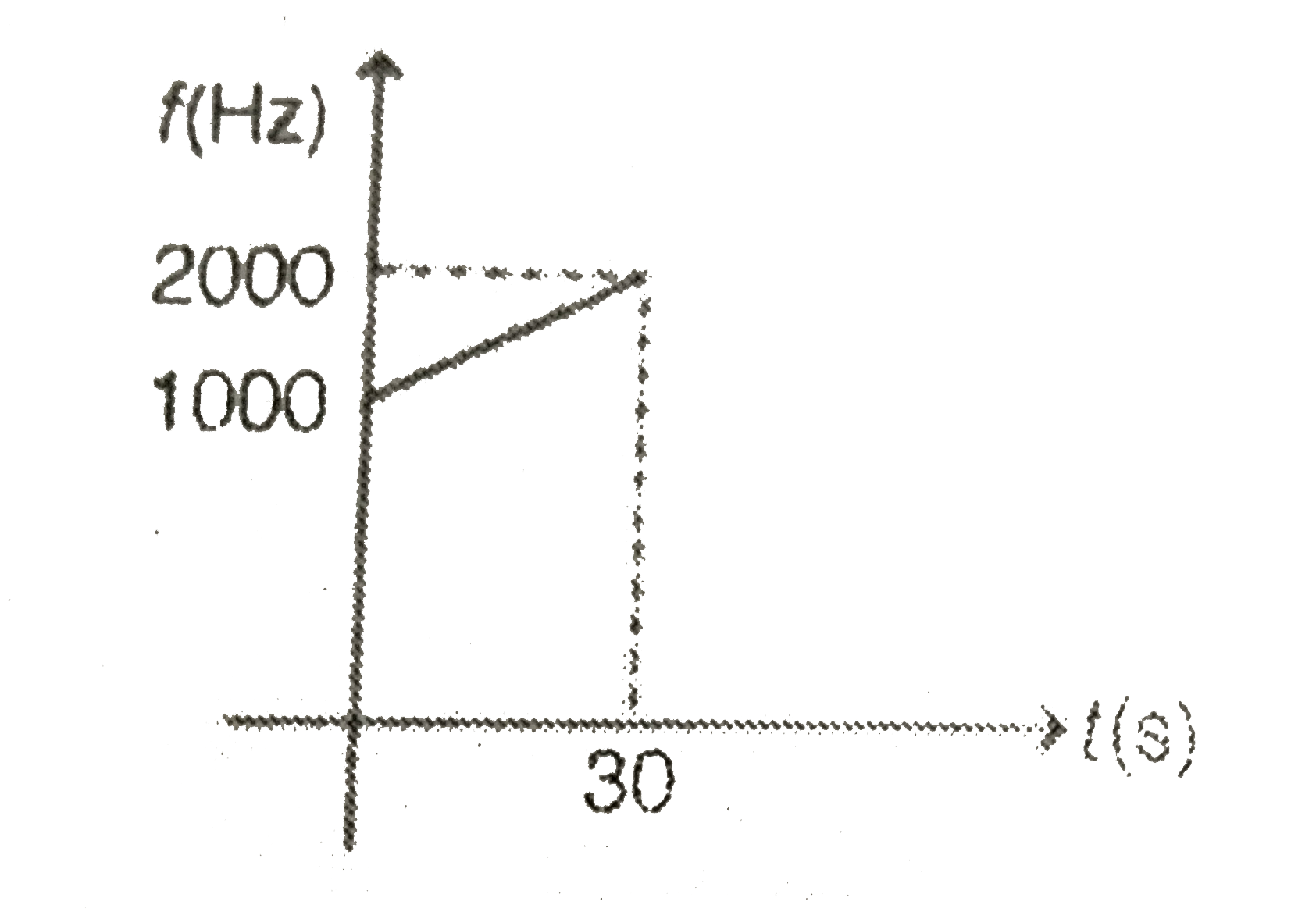At low speeds, the drag force exerted by air is directly proportional to speed i.e., Fdrag=cv. Here, c is the constant. To determine the value of c,a small ball shaped buzzer is dropped from a high tower and the frequency recorded. It is observed that the frequency of sound decreases from an initial value of 704 Hz and becomes constant 686 Hz. taking speed of sound in air as 343 m/s and g=10m/s2, determine the value of constant 'c' (in kg/s). the mass of buzzer is 1.8 kg.
To determine the value of the constant c in the drag force equation Fdrag=cv, we can follow these steps:
Step 1: Understand the relationship between frequency, speed of sound, and the speed of the buzzer
Given:
- Initial frequency f=704Hz
- Final frequency f′=686Hz
- Speed of sound in air vs=343m/s
The frequency of sound changes as the buzzer falls. The relationship can be expressed as:
f′=f⋅vsvs+v
where v is the speed of the buzzer at which the frequency becomes constant.
Step 2: Rearrange the equation to find the speed of the buzzer
We can rearrange the equation to solve for v:
686=704⋅343343+v
Cross-multiplying gives:
686(343+v)=704⋅343
Expanding and simplifying:
686⋅343+686v=704⋅343
686v=704⋅343−686⋅343
686v=(704−686)⋅343
686v=18⋅343
Now, divide both sides by 686:
v=18⋅343686
Calculating v:
v=6174686≈9m/s
Step 3: Relate the drag force to the weight of the buzzer
The drag force Fdrag is equal to the weight of the buzzer when it reaches terminal velocity:
Fdrag=mg
where:
- m=1.8kg
- g=10m/s2
Calculating the weight:
Fdrag=1.8⋅10=18N
Step 4: Set the drag force equal to the expression for drag
From the drag force equation:
Fdrag=cv
Substituting in the values we have:
18=c⋅9
Step 5: Solve for c
Now we can solve for c:
c=189=2kg/s
Final Answer
The value of the constant c is 2kg/s.
---
Given:
- Initial frequency f=704Hz
- Final frequency f′=686Hz
- Speed of sound in air vs=343m/s
f′=f⋅vsvs+v
where v is the speed of the buzzer at which the frequency becomes constant.
We can rearrange the equation to solve for v:
686=704⋅343343+v
Cross-multiplying gives:
686(343+v)=704⋅343
Expanding and simplifying:
686⋅343+686v=704⋅343
686v=704⋅343−686⋅343
686v=(704−686)⋅343
686v=18⋅343
Now, divide both sides by 686:
v=18⋅343686
Calculating v:
v=6174686≈9m/s
The drag force Fdrag is equal to the weight of the buzzer when it reaches terminal velocity:
Fdrag=mg
where:
- m=1.8kg
- g=10m/s2
Fdrag=1.8⋅10=18N
From the drag force equation:
Fdrag=cv
Substituting in the values we have:
18=c⋅9
Now we can solve for c:
c=189=2kg/s
The value of the constant c is 2kg/s.
Topper's Solved these Questions
- WAVESBOOK - AAKASH INSTITUTE ENGLISHCHAPTER - WAVESEXERCISE - Assignment (Section-J) (Paragraph Type Questions)
4 Videos
- WAVESBOOK - AAKASH INSTITUTE ENGLISHCHAPTER - WAVESEXERCISE - EXERCISE
20 Videos
- WAVESBOOK - AAKASH INSTITUTE ENGLISHCHAPTER - WAVESEXERCISE - Assignment (Section-I) (Subjective Type Questions)
8 Videos
- WAVE OPTICSBOOK - AAKASH INSTITUTE ENGLISHCHAPTER - WAVE OPTICSEXERCISE - Assignment (Section-J (Aakash Challengers question))
1 Videos
- WORK, ENERGY AND POWERBOOK - AAKASH INSTITUTE ENGLISHCHAPTER - WORK, ENERGY AND POWEREXERCISE - Assignment (SECTION - D)
13 Videos
Similar Questions
An open pipe resonates with a tuning fork of frequency 500Hz . It is observed that two successive notes are formed at distance 16and46cm from the open end. The speed of sound in air in the pipe is
View SolutionA man standing on a platform observes that the frequency of the sound of a whistle emitted by a train drops by 140 Hz. If the velocity of sound in air is 330 m/s and the speed of the train is 70 m/s, the frequency of the whistle is
View Solution
Knowledge Check
The speed of sound in air at 0∘C is nearly :
A1450ms−1B450ms−1C5100ms−1D330ms−1
A pipe 1 m length is closed at one end. Taking the speed of sound in air as 320ms−1 .the air column in the pipe cannot resonate for the frequency (in Hz )
View SolutionA closed organ pipe can vibrate at a minimum frequency of 500 Hz. Find the length of the tube. Speed of sound in air =340ms−1.
View Solutiona bus is moving towards and stationary observer with speed 20 m/s blows a horn of frequency 200 Hz. the frequency of sound heard by the observer is approximately ( take speed of sound 320 m/s)
View SolutionThe temperature at which the speed of sound in air becomes double of its value at 0∘C
View SolutionThe speed of sound in air is independent from its
View SolutionThe frequency of the whistle of a train is observed to drop from 280 Hz to 260 Hz as the train moves away from a stationary listerner on the platform. Calculate the speed of the train, if speed of sound in air is 340 m/s.
View SolutionA detector is released from rest over a source of sound of frequency f0=103Hz. The frequency observed by the detector at time t is plotted in the graph. The speed of sound in air is (g=10m/s2)

View Solution
